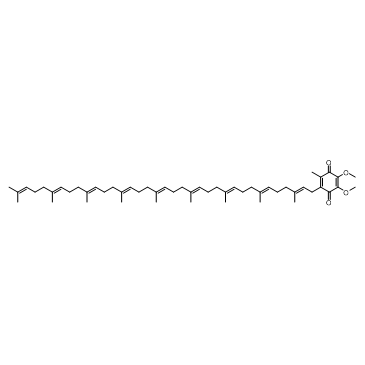Coenzyme Q9 (Ubiquinone Q9) (Synonyms: CoQ9, NSC 226993, Ubiquinone-9, Ubiquinone Q9) |
| Catalog No.GC32470 |
Coenzyme Q9 (Ubiquinone Q9) (Ubiquinone Q9), the major form of ubiquinone in rodents, is an amphipathic molecular component of the electron transport chain that functions as an endogenous antioxidant.
Products are for research use only. Not for human use. We do not sell to patients.

Cas No.: 303-97-9
Sample solution is provided at 25 µL, 10mM.
Coenzyme Q9, a nine isoprenyl group-containing member of the ubiquinone family, is a normal constituent of human plasma.
Both CoQ9 and CoQ10 are equally cardioprotective, as evidenced by their abilities to improve left ventricular performance and to reduce myocardial infarct size and cardiomyocyte apoptosis. HPLC analysis reveals that a substantial portion of CoQ9 has been converted into CoQ10[1]. CoQ10 and CoQ9 are components of themitochondrial respiratory chain in mammals and can regulate some mitochondrial proteins/functions. Soybean, corn, and rapeseed oils are very rich sources of CoQ10, whereas CoQ9 has been found in high concentrations in corn oil[2].
The lack of a functional CoQ9 protein in homozygous CoQ9 mutant (CoQ9(X/X)) mice causes a severe reduction in the CoQ7 protein and a widespread CoQ deficiency and accumulation of demethoxyubiquinone. The deficit in CoQ induces a brain-specific impairment of mitochondrial bioenergetics performance, a reduction in respiratory control ratio, ATP levels and ATP/ADP ratio and specific loss of respiratory complex I. These effects lead to neuronal death and demyelinization with severe vacuolization and astrogliosis in the brain of CoQ9 (X/X) mice that consequently die between 3 and 6 months of age[3].
[1]. Lekli I, et al. Coenzyme Q9 provides cardioprotection after converting into coenzyme Q10. J Agric Food Chem. 2008 Jul 9;56(13):5331-7. [2]. Venegas C, et al. Determination of coenzyme Q10, coenzyme Q9, and melatonin contents in virgin argan oils: comparison with other edible vegetable oils. J Agric Food Chem. 2011 Nov 23;59(22):12102-8. [3]. García-Corzo L, et al. Dysfunctional Coq9 protein causes predominant encephalomyopathy associated with CoQ deficiency. Hum Mol Genet. 2013 Mar 15;22(6):1233-48.
Average Rating: 5 (Based on Reviews and 8 reference(s) in Google Scholar.)
GLPBIO products are for RESEARCH USE ONLY. Please make sure your review or question is research based.
Required fields are marked with *




















